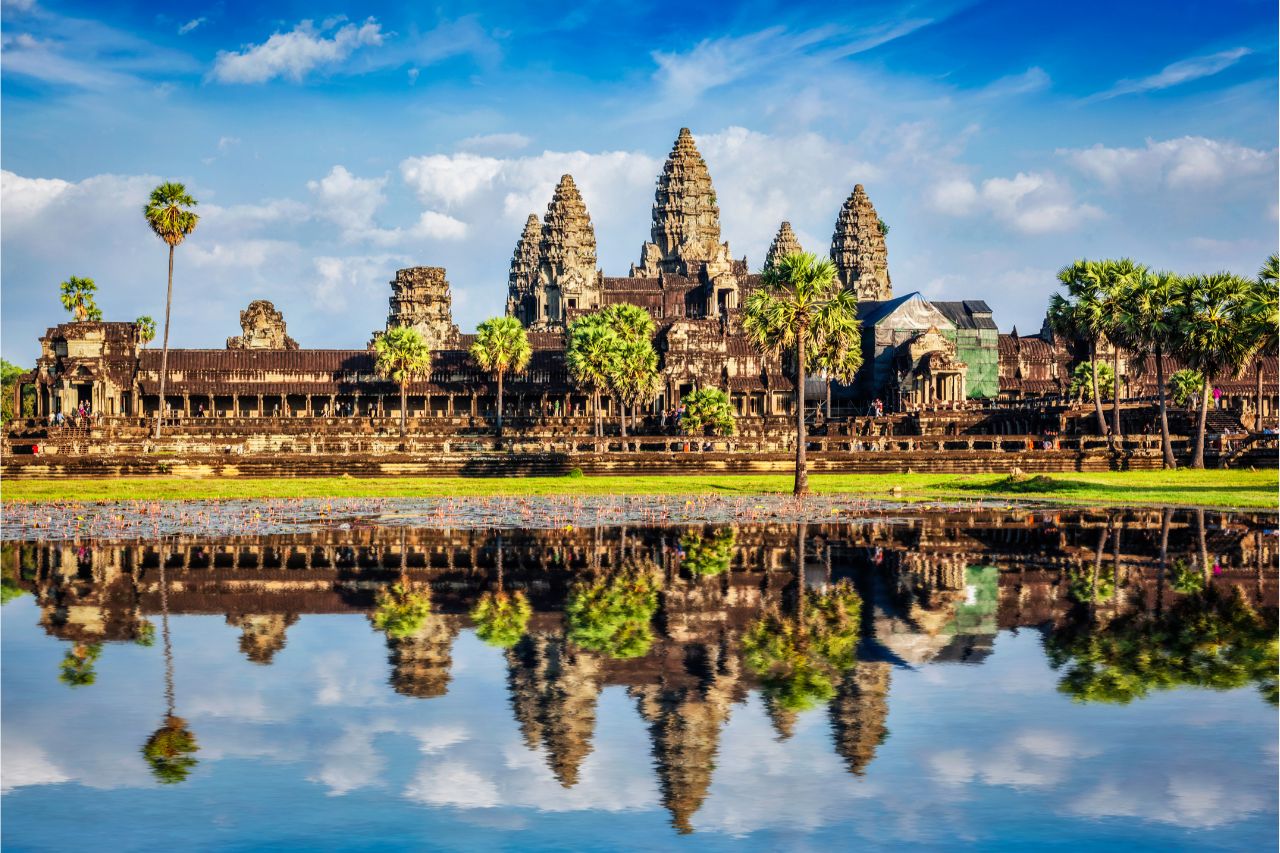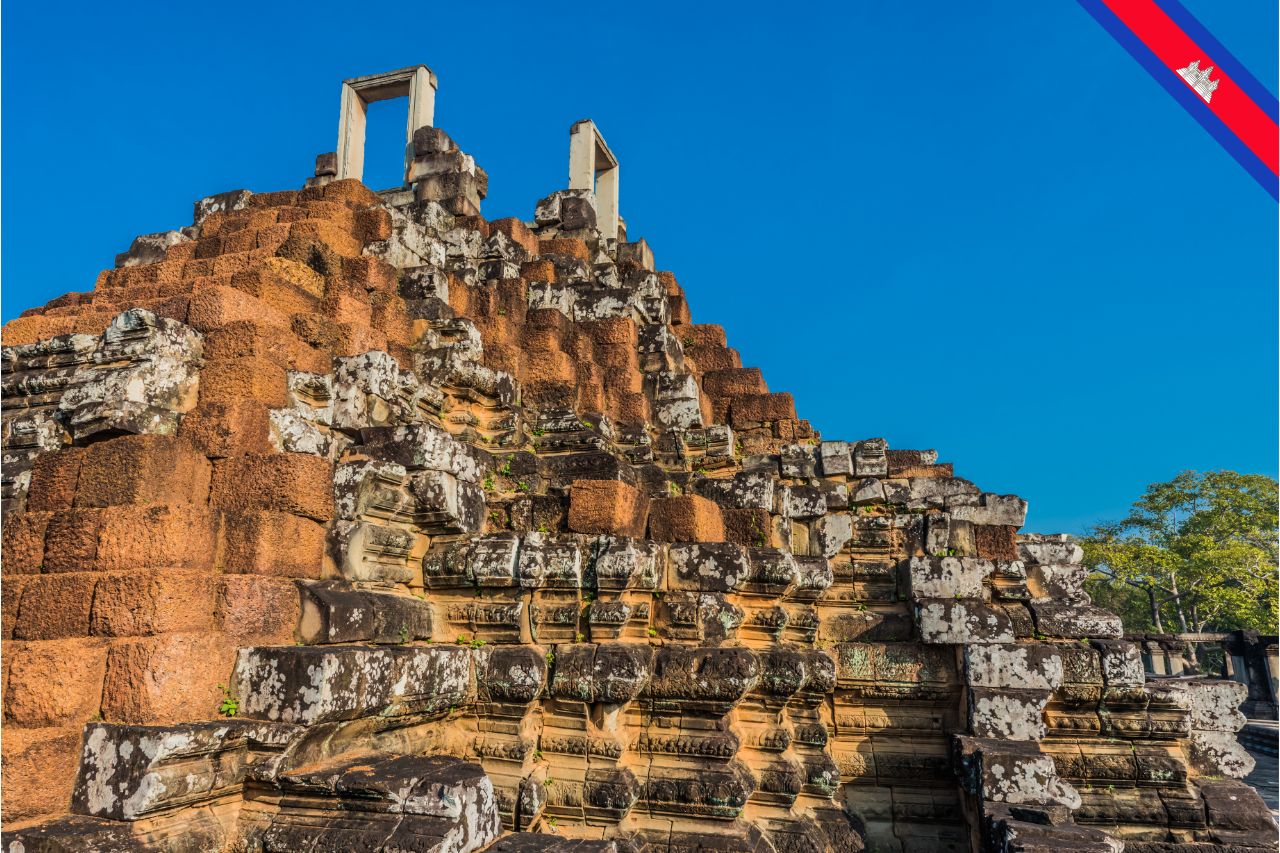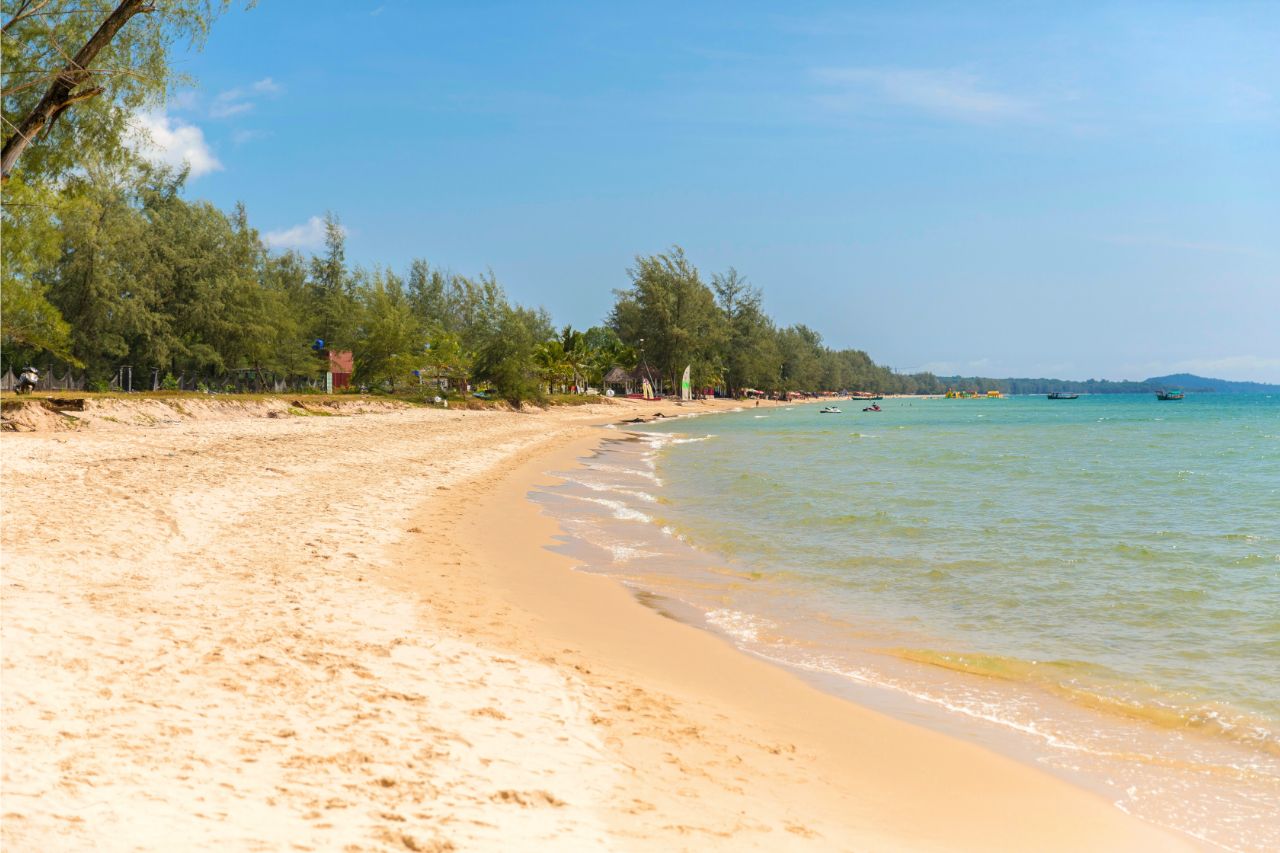The country’s pristine beaches draw sun-seekers, while Angkor’s ancient temples are magnets for spiritual pilgrims. The bustling capital city of Phnom Penh is an example of Cambodia’s blend of French colonial architecture and traditional Khmer culture, while the tranquil riverside town of Battambang offers an authentic glimpse into rural life.
“The best time to visit Cambodia is between November and May, when the country experiences low rainfall and still enjoys warm temperatures. However, the climate in Cambodia is generally hot and humid all throughout the year.”
Phnom Penh
Known as the heartbeat of Cambodia, Phnom Penh offers a bustling art scene, mouthwatering food, and breathtaking architectural displays. Along with parks, eateries, and bars, the pedestrian-friendly riverfront is home to the elaborate Royal Palace and Silver Pagoda. The open-fronted shophouses lining the streets and various monuments in Phnom Penh are remnants of the city’s French colonial past.
PHNOM PENH POPULAR ATTRACTIONS – ENTRANCE FEES (2024)
| Sightseeing | Entrance Fee (USD/Person) | Note |
| Royal Palace | 10 | |
| Tuol Sleng Genocide Museum | 5 | |
| Choeung Ek Genocidal Center | 6 | |
| National Museum | 5 | |
| Wat Phnom | 1 | |
| Silver Pagoda | 3 |
Royal Palace
- Address: Samdach Sothearos Blvd (3), Phnom Penh
- Opening Hours: 08:00 – 11:00 & 14:00 – 17:00
- Entrance Fee: $10/person

It was not until 1866 that Phnom Penh was designated as the capital of Cambodia, following the King’s relocation to the city and the building of an opulent mansion close to the river.
The Royal Palace in Phnom Penh, a magnificent example of Cambodian royal architecture that occupies about 174,870 sqm of the city center, has since become a symbol of the capital and a must-see for tourists with its graceful Khmer roofs, elaborate gilding, and lush gardens.
The Throne Hall, with its 59-meter-tall tower inspired by Angkor’s Bayon, the open-air Chan Chaya Pavilion (Dancing Pavilion), which occasionally hosts classical Khmer dance performances, and the Silver Pagoda, with its sterling silver floor and Buddha statue covered in about 9,000 diamonds, only open for tourists, not all of the Palace.
Tuol Sleng Genocide Museum
- Address: St.113, Boeung Keng Kang III, Boeung Keng Kang Phnom Penh
- Opening Hours: 08:00 – 17:00
- Entrance Fee as follow
| Type of ticket | For | Giá |
| Entrance Ticket | Teenager from 10-18 years | $3 |
| Adult | $5 | |
| Audio Guide | $5 |

The S-21 detention and questioning facility of the Khmer Rouge government is memorialized at the Tuol Sleng Genocide Museum. Situated in the center of Phnom Penh, it preserves artifacts from a tragic era in Cambodian history in an effort to inspire tourists to act as peace ambassadors.
In 1960, under Preah Bat Norodom Sihanouk’s rule, it was initially a secondary school named Tuol Svay Prey High School. It was turned into a torture and interrogation center by the Khmer Rouge in order to force confessions of anti-government sentiment. In addition to the ‘suspected’ father, many victims were women and children who were also detained. Only seven of the approximately 17,000 inmates who were detained there between 1975 and 1978 are known to have survived, according to documents that were found.
Choeung Ek Genocidal Center
- Address: Roluos Village, Sangkat Cheung Aek, Phnom Penh
- Opening Hours: 08:00 – 17:30
- Entrance Fee: $6/person

Through the lens of time and its war museum, you can view Cambodia’s tragic past less painfully at the Choeung Ek Killing Fields (Choeung Ek Genocidal Center). One of the numerous locations of the Khmer Rouge’s mass executions is located about 15 km southwest of the city center. The 1988 Memorial Stupa features the excavated skulls of about 8,000 people arranged by age and sex behind glass panels. While a few were slain and interred at Tuol Sleng, the majority were transported by truck to Choeung Ek during the night.
Apart from the excavated pits, an additional forty-three pits remain undisturbed, and the ultimate startling total remains a mystery. Though Choeung Ek is by no means the largest of the thousands of mass gravesites documented across the nation, the orchard setting does little to ease the horror evoked by this horrific sight. Every year on May 9th, the stupa hosts a memorial service honoring the approximately 1.7 million individuals who perished in the genocide.
National Museum
- Address: Preah Ang Eng St. (13), Phnom Penh
- Opening Hours: 08:00 – 17:00
- Entrance Fee: $5 for foreigner ages from 10 to 17 years old, $10 for foreigner ages from 18 years old up

Located in Phnom Penh, the National Museum of Cambodia is the largest museum dedicated to cultural history and archaeology in the nation.
The National Museum of Cambodia, housed in an impressive red sandstone structure, is a fine example of traditional Khmer architecture. The museum is genuinely a treasure trove of artifacts depicting Khmer and Angkorian culture and history, with over 14,000 engaging exhibits to its name.
The exhibits, which include stone articles, bronze and wood sculptures, ceramic items, and ethnographic items, are divided into four categories: prehistoric, pre-Angkorian, Angkorian, and post-Angkorian. The eight-armed statue of Lord Vishnu, which is believed to have been created in the sixth century, is among its most striking displays. The picture of King Jayavarman VII in a meditative pose, which is on display in the West Gallery along with artworks from Angkor Wat, is another amazing attraction.
Explore the Bronze Gallery of the museum to gain insight into the techniques used for bronze casting during the Angkorian era, which spanned from the 6th to the 13th century. A unique collection of Buddha images from the post-Angkorian era can be found next to the Bronze Gallery.
Wat Phnom
- Address: Wat Phnom Road, Phnom Penh
- Opening Hours: 07:00 – 18:30
- Entrance Fee: $1/person

Wat Phnom is the tallest and most significant temple in the capital city of Phnom Penh, Cambodia. Originally built in 1373, the temple stood 88 feet tall on a man-made mound with a view of the city. Presently, the temple embodies a blend of architectural styles and designs from its extensive 600-year past, encompassing gardens constructed by the French in the late 1800s and shrines symbolizing Taoist, Confucian, and Hindu doctrines.
The majestic main entrance ascends the eastern stairway, with naga—the mythical snakes of Buddhism and Hinduism—and lions watching over its path. A massive bronze Buddha is located inside the temple, and murals depicting the Reamker, the Khmer version of the Ramayana, and his life story cover the walls.
Silver Pagoda
- Address: Oknha Chhun St. (240), Phnom Penh
- Opening Hours: 07:30 – 11:00 & 14:00 – 17:00
- Entrance Fee: $3/person

One of the things you simply must see when in Phnom Penh is the Silver Pagoda. Situated merely a short distance from the Royal Palace, the Silver Pagoda exudes a remarkable charm of conventional Khmer architecture and provides an engaging visit that sheds light on Cambodia’s history and contemporary culture.
The pagoda’s floor, which is covered in over 5,000 large, thick silver tiles—hence the temple’s moniker, Silver Pagoda—is one of its unique features. Additional treasures include a life-size, 90 kg gold statue of Maitreya Buddha adorned with 9584 diamonds and displayed in royal regalia, a multitude of golden Buddha statues in various sizes, the royal crown, gold-inlaid royal swords, and a sitting emerald Buddha from the 17th century set on a gilded pedestal. The Hindu and Cambodian epics are vividly depicted in the exquisite mural paintings that adorn the roofed walls surrounding the temple.
Siem Reap
Siem Reap is home to hundreds of man-made and natural attractions, including breathtaking temples, exquisitely restored colonial buildings, one-of-a-kind museums, cultural theme parks, large lakes, and lush mountains. The numerous beautifully preserved stone carvings at Buddhist and Hindu temples will delight history buffs, and outdoor enthusiasts can engage in a variety of activities like hiking, bird watching, picnicking, and swimming. There are many different cultural dances and traditional performances in the heart of Siem Reap that offer an insight into the way of life of the locals.
SIEM REAP POPULAR ATTRACTIONS – ENTRANCE FEES (2024)
| Sightseeing | Entrance Fee (USD/Person) | Note |
| Angkor Wat | 37 | |
| Bayon Temple | included in the Angkor ticket | |
| Ta Prohm | ||
| Angkor Thom | ||
| Banteay Srei |

Angkor Wat
- Address: Krong Siem Reap
- Opening Hours: 07:30 – 17:30
- Entrance Fee: $37/person
The grandeur of Angkor Wat is matched by very few locations on the planet. The temple is a true wonder of the world, one of the biggest religious monuments ever constructed. Angkor Wat, perhaps the best-preserved of all the Angkorean temples, is thought to have been built as a temple and mausoleum for King Suryavarman II during the height of the Khmer empire in the first half of the 12th century.
The temple itself occupies a perfect square kilometer and is surrounded by a moat and an outer wall that measures 1,300 meters by 1,500 meters. It is made up of three terraces that are topped by five towers that resemble lotuses.
The three spires of Angkor Wat symbolize the traditional temple mountain of Mount Meru, the residence of the gods in Hinduism (the Angkor people were originally Hindu and subsequently Buddhist). This type of architecture is typical of Khmer architecture.
Bayon Temple
- Address: Angkor Thom Angkor Archeological Park, Krong Siem Reap
- Opening Hours: 07:30 – 17:30
- Entrance Fee: is included in the Angkor ticket

One of the most well-known, well-liked, and exquisite buildings in the Angkor Wat Archaeological Park is the Bayon Temple. Located north of Angkor Wat, the temple originally served as the hub of the ancient Angkor Thom city. It is most recognized for the numerous towers that each have a gently smiling faces on it.
The abandoned temple is surrounded by about fifty towers, with more than 200 faces exhibiting various levels of wear and erosion. Each face is four meters high and faces one of the compass’s cardinal directions. They all have the same contented smile and closed eyes, signifying an all-knowing, peaceful, and possibly even nirvanic state. Around the temple are also numerous intricate and beautiful bas-reliefs that depict a variety of scenes, including market scenes, naval and land combat, and even the building of the temple.
Ta Prohm
- Address: Krong Siem Reap
- Opening Hours: 07:30 – 17:30
- Entrance Fee: is included in the Angkor ticket

Among the temple complexes in Siem Reap, Cambodia, Ta Prohm is one of the most visited and frequently photographed. This place feels mystical and almost secretive, with enormous tree roots winding across crumbling stone walls, ancient trees towering overhead, and long, dark hallways and courtyards to explore.
The Ta Prohm temples were built in the twelfth and thirteenth centuries and fell into disrepair following the collapse of the Khmer Empire in the fifteenth century. Ta Prohm was engulfed by the Cambodian jungle for hundreds of years. As the trees grew larger, they started to collapse the stone walls from the tops of the walls. The intrusive, massive tree roots of these old trees are what contribute to Ta Prohm’s allure and mystique.
Recently, restoring and safeguarding this amazing little place in Cambodia, scaffolding, metal supports, wooden walkways, and rope fences are being added.
Angkor Thom
- Address: Angkor Thom, Siem Reap
- Opening Hours: 05:00 – 17:30
- Entrance Fee: is included in the Angkor ticket

Known as “Great City,” Angkor Thom served as the Khmer Empire’s final and most resilient capital. It was founded as the royal capital of King Jayavarman VII in the late 12th century. The massive scale of construction, the extensive use of laterite, the face-towers at each of the city’s entrances, and the enormous figures that adorn each tower—each carrying a naga—all exhibit the Bayon style of Angkor Thom. The most popular site within the Angkor Complex, after Angkor Wat, is Angkor Thom, which draws visitors from all over the world.
Banteay Srei
- Address: National Road No. 6a, Krong Siem Reap
- Opening Hours: 05:00 – 17:00
- Entrance Fee: is included in the Angkor ticket

A hidden gem that enthralls everyone who visits is tucked away amid Cambodia’s verdant surroundings. Known as the “Citadel of Women,” Banteay Srei is a complex of temples that is a testament to the magnificent Khmer craftsmanship and the architectural genius of the past.
Banteay Srei’s walls are covered in ornate carvings that tell tales from mythology and feature celestial dancers and elaborate floral motifs. The temple’s allure is enhanced by the use of pink sandstone, which lends it a distinctive elegance that has earned it the title of “Jewel of Khmer Art.”
Sihanoukville
The seaside town is well-known for having some of Cambodia’s greatest beaches, which makes it the preferred escape point for Phnom Penhn’s urban residents. These components work together to make Sihanoukville a well-liked tourist destination in the nation.

Otres Beach
- Address: Sihanoukville
- Opening Hours: All day
- Entrance Fee: Free
Otres is one of the Top 22 Beaches in Asia according to Forbes, and it offers a more laid-back, peaceful ambiance. You can freely try windsurfing, kayaking, and sailboat sailing by renting them from businesses on the beach. Near the coast are numerous little fishing villages where you can visit to find out more about the life of a fisherman if you’re interested.
Koh Rong
- Address: Sihanoukville
- Opening Hours: All day
- Entrance Fee: Free

Unquestionably, Koh Rong boasts some of Southeast Asia’s most exquisite beaches! Referred to as the Maldives of Cambodia, this unspoiled location hasn’t been noticed by many travelers and still has the allure of a small island.
Koh Rong has a number of beaches, each with its own distinct personality and allure. Stretching over 7 km, Long Beach is the island’s most visited beach. It’s ideal for swimming, tanning, and taking in the stunning views of the neighboring islands. If you want to get away from the crowds and have a more private beach experience, Sok San Beach is a great choice. If you want something a little more daring, head over to Lonely Beach. It’s a secluded beach that can only be reached by boat in the island’s southern region. There are various hiking trails to explore, and the beach is encircled by thick jungle.
Koh Rong Samloem
- Address: Sihanoukville
- Opening Hours: All day
- Entrance Fee: Free

An island in Cambodia is known as Koh Rong Samloem, sometimes spelled Kaoh Rong Sanloem. Even though this location receives less tourists than its sister island Koh Rong, it is still quite lovely! This idyllic island is well-known for its warm, clear waters, white sand beaches, and rich underwater biodiversity, which includes the amazing, light-emitting bioluminescent plankton.

